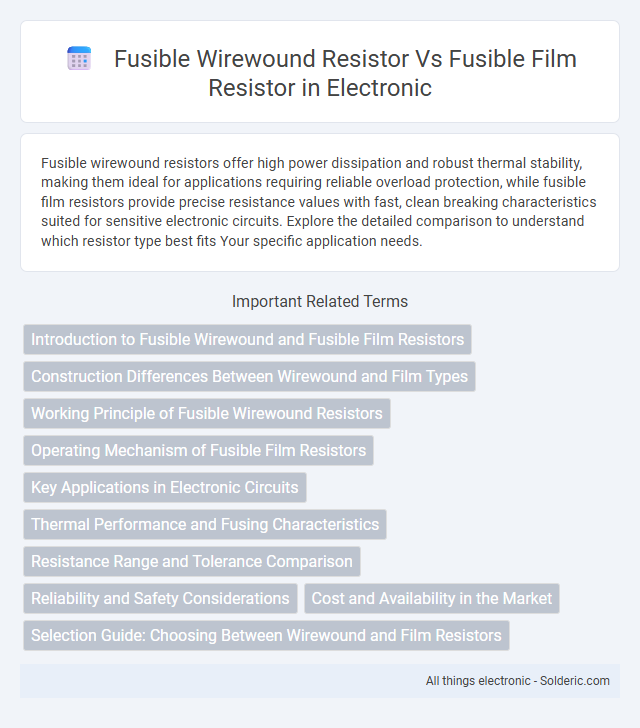Fusible wirewound resistors offer high power dissipation and robust thermal stability, making them ideal for applications requiring reliable overload protection, while fusible film resistors provide precise resistance values with fast, clean breaking characteristics suited for sensitive electronic circuits. Explore the detailed comparison to understand which resistor type best fits Your specific application needs.
Comparison Table
| Feature | Fusible Wirewound Resistor | Fusible Film Resistor |
|---|---|---|
| Construction | Wire coil wound on ceramic or fiberglass core | Thin metal film deposited on ceramic substrate |
| Power Rating | Typically higher (up to several watts) | Generally lower power rating (fraction of watts to few watts) |
| Fusing Characteristics | Clear, immediate fusing under overload for circuit protection | Precise fusing with less thermal inertia, good for sensitive circuits |
| Resistance Range | Wide range, from milliohms to kilo-ohms | Narrower range, usually higher resistance values |
| Temperature Coefficient | Higher TCR, less stable under temperature variations | Lower TCR, better stability |
| Application | High power, surge protection, fuse function in power supplies | Sensitive electronic circuits, precision fuse elements |
| Cost | Generally higher due to materials and construction | Lower cost, suitable for mass production |
Introduction to Fusible Wirewound and Fusible Film Resistors
Fusible wirewound resistors feature a wire element designed to melt and safely interrupt the circuit during overloads, providing robust protection in high-current applications. Fusible film resistors use a thin film layer engineered to vaporize under fault conditions, offering precise and reliable circuit breaking with faster response times. Your choice between these depends on the required tolerance, power rating, and specific safety standards for the application.
Construction Differences Between Wirewound and Film Types
Fusible wirewound resistors feature a metal wire coil wound around a ceramic or fiberglass core, providing superior power dissipation and durability for high-current applications. In contrast, fusible film resistors consist of a thin resistive film deposited on a ceramic substrate, offering precise resistance values but limited power handling. Your choice depends on the specific construction benefits needed, such as robustness from wirewound types or compactness and accuracy from film resistors.
Working Principle of Fusible Wirewound Resistors
Fusible wirewound resistors operate by using a resistive wire coil wound around an insulating core, which acts as both a current-limiting and protective element. When an overcurrent or fault condition occurs, the wire heats up to a point where it melts or fuses, interrupting the electrical circuit and preventing damage to other components. This melting mechanism provides a clear fail-safe by physically breaking the circuit, distinguishing it from fusible film resistors that rely on thin film properties for similar protective functions.
Operating Mechanism of Fusible Film Resistors
Fusible film resistors operate by utilizing a thin resistive film layer that rapidly melts and opens the circuit when subjected to excessive current, providing reliable overcurrent protection. Unlike wirewound resistors, which rely on a fusible wire element that burns out under fault conditions, fusible film resistors achieve fast response through their micro-layered construction. This precise breaking mechanism enhances safety and prevents damage to sensitive electronic components in various applications.
Key Applications in Electronic Circuits
Fusible wirewound resistors excel in power circuits, providing robust short-circuit protection and high surge current handling in applications like power supplies and motor drives. Fusible film resistors are ideal for compact electronic devices requiring precise overcurrent protection and fast disconnection, such as consumer electronics and telecommunications equipment. Your choice depends on circuit size constraints and the level of fault tolerance needed.
Thermal Performance and Fusing Characteristics
Fusible wirewound resistors excel in thermal performance due to their metal wire construction, which allows superior heat dissipation and higher power ratings compared to fusible film resistors. Fusible film resistors typically have faster fusing characteristics, melting quickly under overload to protect circuits more rapidly, but they handle less sustained thermal stress. Your choice depends on whether prolonged thermal stability or rapid fusing response is critical for your application.
Resistance Range and Tolerance Comparison
Fusible wirewound resistors typically offer a resistance range from 0.1 ohms up to several kilo-ohms with tight tolerances as low as +-1%, making them suitable for precise overcurrent protection applications. Fusible film resistors generally provide a higher resistance range, often from 10 ohms to several mega-ohms, but with looser tolerances around +-5%, favoring use in high-voltage circuit protection. Your choice between these resistor types depends on the specific resistance precision and range requirements of your electronic design.
Reliability and Safety Considerations
Fusible wirewound resistors offer superior reliability under high surge currents due to their robust metal wire construction, which withstands thermal stress and prevents catastrophic failure. Fusible film resistors, while compact and cost-effective, pose higher safety risks as their thin film elements may fail abruptly, potentially causing short circuits or fires. To ensure optimal safety and durability, your choice should align with the application's current rating and fault tolerance requirements.
Cost and Availability in the Market
Fusible wirewound resistors generally cost more due to their robust construction and reliability under high power conditions, making them less widely available than fusible film resistors, which are mass-produced and cost-effective. You will find fusible film resistors more easily in the market, especially for standard applications where extreme power ratings are not required. The affordability and broader availability of fusible film resistors make them the preferred choice for budget-sensitive projects.
Selection Guide: Choosing Between Wirewound and Film Resistors
Wirewound resistors offer high power ratings and excellent thermal stability, making them ideal for applications requiring precise current limiting and overload protection. Fusible film resistors provide fast-acting protection with lower inductance and enhanced precision, suitable for sensitive electronic circuits with transient voltage spikes. Selection depends on power dissipation needs, response time, and circuit sensitivity, where wirewound excels in high-power scenarios and film resistors in high-speed fuse action and accuracy.
fusible wirewound resistor vs fusible film resistor Infographic

 solderic.com
solderic.com